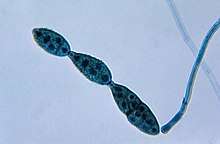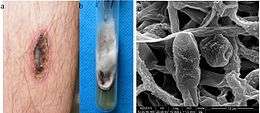Alternaria
Alternaria is a genus of ascomycete fungi. Alternaria species are known as major plant pathogens. They are also common allergens in humans, growing indoors and causing hay fever or hypersensitivity reactions that sometimes lead to asthma. They readily cause opportunistic infections in immunocompromised people such as AIDS patients.
| Alternaria | |
|---|---|
 | |
| Scientific classification | |
| Kingdom: | Fungi |
| Division: | Ascomycota |
| Class: | Dothideomycetes |
| Order: | Pleosporales |
| Family: | Pleosporaceae |
| Genus: | Alternaria Nees |
| Species | |
|
Many, see text | |
There are 299 species in the genus;[1][2] they are ubiquitous in the environment and are a natural part of fungal flora almost everywhere. They are normal agents of decay and decomposition. The spores are airborne and found in the soil and water, as well as indoors and on objects. The club-shaped spores are single or form long chains. They can grow thick colonies which are usually green, black, or gray.[2]
At least 20% of agricultural spoilage is caused by Alternaria species; most severe losses may reach up to 80% of yield, though.[2] Many human health disorders can be caused by these fungi, which grow on skin and mucous membranes, including on the eyeballs and within the respiratory tract. Allergies are common, but serious infections are rare, except in people with compromised immune systems. However, species of this fungal genus are often prolific producers of a variety of toxic compounds. The effects most of these compounds have on animal and plant health are not well known. Many species of alternaria modify their secondary metabolites by sulfoconjugation,[3] however the role of this process is not yet understood. The terms alternariosis and alternariatoxicosis are used for disorders in humans and animals caused by a fungus in this genus.
Not all Alternaria species are pests and pathogens; some have shown promise as biocontrol agents against invasive plant species. Some species have also been reported as endophytic microorganisms with highly bioactive metabolites.
The genus is now known to be polyphyletic.[4]
Species

Some species include:
- Alternaria alternata – Causes early blight of potato, Leaf spot disease in Withania somnifera[6] and can infest many other plants. It also causes upper respiratory infections in AIDS patients, asthma in people with sensitivity, and has been implicated in chronic rhinosinusitis.
- Alternaria alternantherae
- Alternaria arborescens – causes stem canker of tomato
- Alternaria arbusti – causes leaf lesions on Asian pear
- Alternaria blumeae – causes lesions on Blumea aurita
- Alternaria brassicae – infests many vegetables and roses[2]
- Alternaria brassicicola – grows on cole crops[2]
- Alternaria burnsii – causing cumin blossom blight
- Alternaria carotiincultae – causes leaf blight on carrot
- Alternaria carthami
- Alternaria celosiae
- Alternaria cinerariae
- Alternaria citri – causes black rot on citrus plants
- Alternaria conjuncta – grows on parsnip
- Alternaria cucumerina – grows on various cucurbits
- Alternaria dauci – grows on carrot
- Alternaria dianthi
- Alternaria dianthicola
- Alternaria eichhorniae – infests water hyacinth plants, used as bioherbicide against these weeds
- Alternaria euphorbiicola – infests cole crops
- Alternaria gaisen – causes ringspot disease of pear
- Alternaria helianthi
- Alternaria helianthicola
- Alternaria hungarica
- Alternaria infectoria – infests wheat
- Alternaria japonica – infests cole crops
- Alternaria limicola – earliest diverging lineage of Section Porri
- Alternaria linicola
- Alternaria longipes – infects tobacco
- Alternaria mali
- Alternaria molesta – may cause skin lesions on porpoises
- Alternaria panax – causes ginseng blight
- Alternaria perpunctulata
- Alternaria petroselini – causes parsley leaf blight
- Alternaria porri
- Alternaria radicina – causes carrot decay
- Alternaria raphani
- Alternaria saponariae
- Alternaria selini – causes parsley crown decay
- Alternaria senecionis
- Alternaria solani – causes early blight in potatoes and tomatoes
- Alternaria smyrnii – infests alexanders and parsleys
- Alternaria tenuissima
- Alternaria triticina
- Alternaria zinniae
References
- Kirk PM, Cannon PF, Minter DW, Stalpers JA (2008). Dictionary of the Fungi. 10th ed. Wallingford: CABI. p. 22. ISBN 0-85199-826-7.
- Nowicki, Marcin; et al. (30 August 2012). "Alternaria black bpot of crucifers: Symptoms, importance of disease, and perspectives of resistance breeding". Vegetable Crops Research Bulletin. 76. doi:10.2478/v10032-012-0001-6.
- Kelman, MJ; Renaud, JB; Seifert, KA; Mack, J; Sivagnanam, K; Yeung, KK; Sumarah, MW (15 October 2015). "Identification of six new Alternaria sulfoconjugated metabolites by high-resolution neutral loss filtering". Rapid Commun Mass Spectrom. 29 (19): 1805–1810. doi:10.1002/rcm.7286. PMID 26331931.
- Aschehoug, Erik T.; Metlen, Kerry L.; Callaway, Ragan M.; Newcombe, George (2012). "Fungal endophytes directly increase the competitive effects of an invasive forb" (PDF). Ecology. 93 (1): 3–8. doi:10.1890/11-1347.1. PMID 22486080. Archived from the original (PDF) on 2014-04-28. Retrieved July 8, 2013.
- Ran Yuping (2016). "Observation of Fungi, Bacteria, and Parasites in Clinical Skin Samples Using Scanning Electron Microscopy". In Janecek, Milos; Kral, Robert (eds.). Modern Electron Microscopy in Physical and Life Sciences. InTech. doi:10.5772/61850. ISBN 978-953-51-2252-4.
- Pati, Pratap Kumar; Sharma, Monica; Salar, Raj Kumar; Sharma, Ashutosh; Gupta, A. P.; Singh, B. (8 January 2009). "Studies on leaf spot disease of Withania somnifera and its impact on secondary metabolites". Indian Journal of Microbiology. 48 (4): 432–437. doi:10.1007/s12088-008-0053-y. PMC 3476785. PMID 23100743.
Other sources
- Lawrence, DP; Park, MS; Pryor, BM (2012). "Nimbya and Embellisia revisited, with nov. comb. for Alternaria celosiae and A. perpunctulata". Mycological Progress. 11 (3): 799–815. doi:10.1007/s11557-011-0793-7.
- Lawrence, DP; Gannibal, PB; Peever, TL; Pryor, BM (2013). "The sections of Alternaria: formalizing species-group concepts". Mycologia. 105 (3): 530–546. doi:10.3852/12-249. PMID 23687125.
- Asan, A (2015). "Checklist of Alternaria Species Reported From Turkey". Mantar Dergisi. 6 (2): 43–57. doi:10.15318/Fungus.2015214064.
External links
| Wikimedia Commons has media related to Alternaria. |
| Wikispecies has information related to Alternaria |